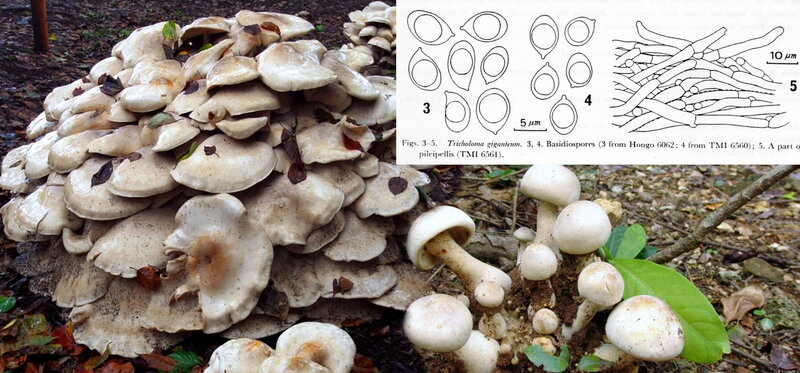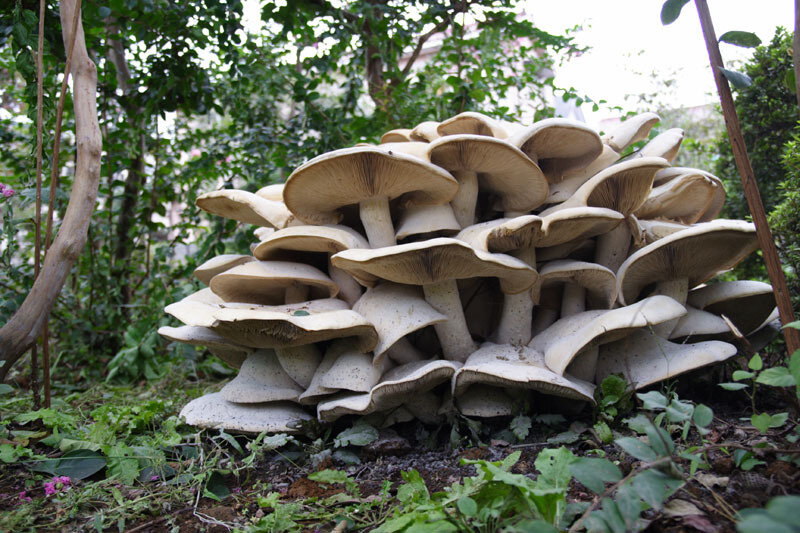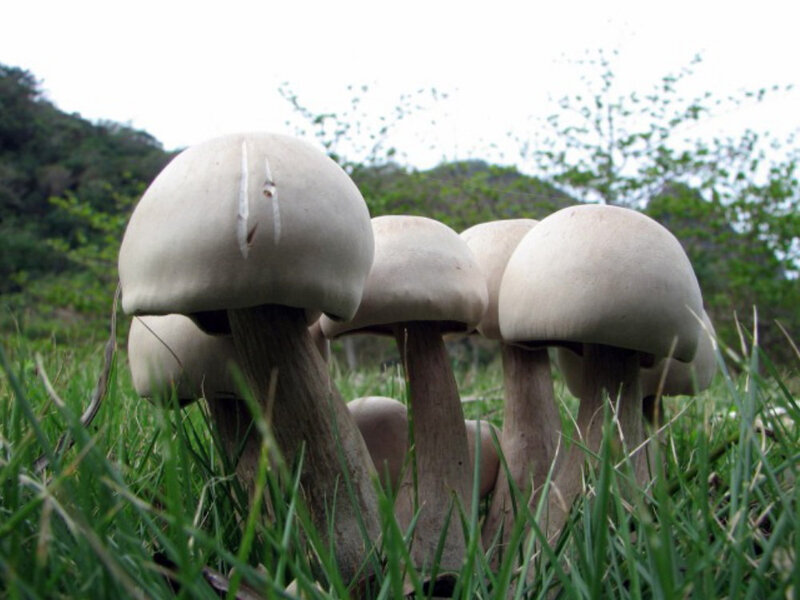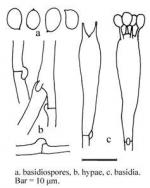Tricholome géant ニオウシメジ Macrocybe gigantea
|
An Agaric new to Japan* 長沢 栄史・本郷 次雄 :日本新産種ニオイシメジについて Eiji NAGASAWA**・Tsuguo HONGO*** |
||
|
Tricholoma giganteum Massee 1912
|
||
|
Tricholome géant, Tricholome remarquable (ニオウシメジ)
|
||
|
|
Summary Description and figures of Tricholoma giganteum Massee, a new species from Japan, are given on the basis of collections from Kumamoto Prefecture (Kyushu) and the islands of Tanegashima, Okinawa and Ié, Japan. Tricholoma lobayense and Tricholoma spectabilis are considered to be later synonyms of T. giganteum.
Tricholoma giganteum Massee, which was originally reported from India (Massee 1912), is recorded here for the first time from Japan with a description and figures on the basis of the collections from Kumamoto Pref. (Kyushu), Tanagashima Is., Okinawa Is. and Ié Is.
Colour notations in the description, e.g. 4C3 are taken from Kornerup and Wanscher (1967). The collections examined have been deposited at the Herbarium of the Tottori Mycological Institute (TMI) and at the Herbarium in Shiga University, Otsu.
- Basidiomycota / Homobasidiomycetes / Tricholomatales / Tricholomataceae
- Synonymes :
Macrocybe gigantea (Massee) Pegler et Lodge 1998 ;
Tricholoma lobayense Heim, Rev. Mycol. 34 : 346. 1970 ;
T. spectabilis Peerally et Sutra, Rev. Agr. et Sucrière de l'Île Maurice 53 : 117. 1973 - Carpophores (Figs. 1, 2) very large, relatively slender, cespitose. Pileus (4-) 12-32 cm broad, convex at first, finally plane or more or less depressed with raised margin, at times boradly umbonate, nearly glabrose ; colour beige (4C3) or grayish beige (4C2), ivory (4B3) or putty (4B2), in rare cases, becoming brown (6E5-6) to dark brown (6F6-7) in damaged portions when old ; margin long, remaining strongly inrolled, often wavy undulate when old.
- Lamellae emarginate-adnexed to sinuate, seceding, more or less crowded, putty (4B2) at first then straw yellow (3B4), very narrow at first, then becoming broad and up to 20 mm wide; edges somewhat eroded when old.
- Stipe 12-47 cm long or more, 1 - 3,5 cm thick at apex, 1.5-7(10) cm at base, cylindric to subclavate (especially when young), connate at base, solid to stuffed ; surface fibrillose-rugose, glabrous to somewhat floccose, streaded with the same colour as pileus on whitish ground.
- Flesh white, firm, thick at disk ; taste mild; odor more or less farinaceous.
- Spores (Figs. 3-4) white in deposit ; (4-)5-7.5 x 3,5-5 µm, ovoid to broadly ellipsoid, thin-walled, smooth, often 1-guttulate, inamyloid, acyanophilic. Basidia 4-spored, 25-37,5 x 6-7,5 µm, narrowly clavate, carminophilous granules absent. Cystidia absent. Hymenophoral trama regular, of cylindrical hyphae 3-10 µm broad. Clamp connections present.
- Habitat : Bare hill slopes, Matsubae-cho, Shimomashiki-gun, Kumamoto Pref., Kyushu/ Oct. 24, 1974, coll. M. Ando & al. (Hongo 6062); on paths, along a sweet potato field. Nokan, Nakatané-cho (Tanegashima Is.), Kagoshima Pref., Oct. 1978, coll. H. Kajiwara (Hongo 5854); in a small bush remaining in the middle of sugar cane field, Yomitan-son (Okinawa Is), Okinawa Pref., Aug. 23, 1978, coll. M.Tobaru (Hongo 5876); in a sugar cane field, same locality, mid- and late June, 1979, collector unknown (TMI 6560 and 6561 -- both specimen in the Kew herbarium) ; in a sugar cane field, Higashi-Egami, Ié-son (Ié Is.), Okinawa Pref., Sep. 29, 1980, coll. K. Nakajima (Hongo 6216).
- Distribution : Kyushu [Matsubae-cho (ca.32°39' N. lat.), Kumamoto Pref. is the northern most locality of this fungus in Japan, so far as we are aware]m Tanegashima Is., Okinawa Is. and Ie Is..
This species is well characterized by large, beige to ivory colored carpophores growing in dense clusters and the small ovoid spores. The clamped hyphae and the lack of cystidia are important additional microscopical characters.
T. lobayense Heim from Central Africa (Heim, 1970), Nigeria (Zoberi, 1972) and Tanzania (Pegler, 1977), and T. spectabilis Peerally & Sutra from Maurice Is. [Mauritius] (Peerally & Sutra, 1973; Peerally, 1979) are identical to T. giganteum in most essential characters and can safely be treated as later synonyms over which it has priority.
Heim, R. 1970. Breves diagnoses latinae novitatum genericarum specificarumque nuper descriptarum. Rev. Mycol. 34 : 333-347.
Massee (1912). Bulletin of miscellaneous information - Royal botanic Gardens, Kew, 1912(6), p. 254
- Chapeau :12-32 cm, d'abord convexe, puis plan et plus ou moins déprimé avec une marge dressée, parfois largement umbonné; revêtement presque glabre, beige, gris-beige, ivoire ou mastic, rarement devenant brun à brun foncé dans les blessures avec l'âge. Marge longtemps involutée, souvent sinueuse avec l'âge.
- Stipe :12-47 cm de hauteur, épaisseur de 1-3,5 cm au sommet, 1,5-7 (-12) cm à la base, cylindrique à subclavé (surtout les jeunes), connés ou cespiteux à la base. Revêtement fibrilleux-rugueux, glabre à un peu floconneux, concolore, sur fond blanchâtre.
- Spores blanches en masse, 5-7,5 x 3,5-5 µm, ovoïdes à largement ellipsoïdes, à paroi mince, lisse, souvent avec une guttule, non-amyloïdes, non cyanophiles. Basides tétrasporiques, 25-37,5 x 6-7,5 µm, étroitement clavées, granulations carminophiles absentes. Acystidié.
- Bon comestible
- Références bibliographiques : TMSJ 22 p. 181-185 (1984) ; IH1 97 ; IOH p. 75
- Commentaires : Décrit par Massee depuis l'Inde en 1912, puis de l'ile Maurice et du Nigeria par Heim, Peerally et Sutra, enfin récoltée régulièrement au sud du Japon depuis 1978, cette espèce de très grande taille et relativement élancée, a été recombinée en 1998 dans le genre Macrocybe. Cultivée depuis peu en Inde, Chine, Japon. Aurait des propriétés anti-tumorales...
Macrocybe spectabilis (Peerally & Sutra) Pegler & Lodge, in Pegler, Lodge & Nakasone, Mycologia 90(3): 499 (1998)






/http%3A%2F%2Fstorage.canalblog.com%2F66%2F88%2F1309869%2F128327343_o.jpg)
/http%3A%2F%2Fstorage.canalblog.com%2F98%2F34%2F1309869%2F127348059_o.jpg)
/http%3A%2F%2Fstorage.canalblog.com%2F30%2F44%2F1309869%2F124704909_o.jpg)
/http%3A%2F%2Fstorage.canalblog.com%2F04%2F96%2F1309869%2F128277814_o.jpg)